Content
Content:
- Botanical description
- Growing at home
- Landing
- Care
- Flowering tree
- Application
Among exotic plants, there are species that can live in temperate climatic conditions. One of them is tulip liriodendron, or lyran (lat.Liriodendron tulipifera). It is also called the real tulip tree. It belongs to the Magnoliaceae family. The eastern territories of North America are considered the homeland of the species.
Botanical description
Liriodendron is a large deciduous plant with a taproot system. Adults reach a height of more than 50 m.The crown width sometimes exceeds 1.5 m.
The trunks are massive, straight, without branching, have a greenish-gray smooth bark. With age, it becomes covered with frequent shallow grooves. Lateral shoots are located at an acute angle, far from the trunk. Young branches are brownish, smooth, covered with a thin waxy coating. Trees from the first years of life have a neat pyramidal crown. With age, it expands, becomes spreading.
Lyran leaves are large, four-lobed, with a notched apex... Their size reaches 20 cm in length and 14 cm in width. The surface is smooth, with fine feathery veins. On the branches, they are located alternately, hanging on 7-centimeter cuttings. Leaves are light green, sometimes with bright yellow stripes.
Liriodendron flowers are single, regular cupped, 6–8 cm in size. They look like tulip buds. The petals of the corolla are slightly elongated, with even edges, the lower ones are bent down, the upper ones are raised. The color of the flowers is pale yellow, cream in some varieties. At the base, the petals are greenish, in the middle they have a bright orange edging. Stamens are numerous, elongated, yellow.
The leaves and flowers of the tulip tree emit a light, cucumber-like, sweetish aroma.
Brown cone-shaped fruits about 5 cm in diameter are formed in place of wilting flowers, have a wide base and numerous lionfish with seeds. After ripening, they break off and are carried by the wind, sometimes remain on the branches until the next spring.
In its natural environment, the tulip tree prefers to grow on drained, breathable soils, sufficiently nutritious, with a high humus content. Lyran's lifespan reaches 450-500 years.
The high decorative qualities of the tulip tree were the reason for its introduction to Europe. Initially, they were planted only in the subtropics, then they began to grow in temperate latitudes. Most specimens tolerate frosts down to -35 ° C, mature trees are quite drought-resistant.
Growing at home
Don't be afraid to cultivate the North American tulip tree outdoors. With proper care, it takes root well. Also, this plant is suitable for growing as a indoor bonsai crop.
Liriodendrons stretch by 80-100 cm per year... In adults, a massive, wide, dense crown, therefore, it is necessary to place the tulip tree away from buildings and fences.It is suitable only for owners of large areas. In small gardens, this plant will be very crowded, a wide crown will drown out other crops over time. It is better to grow lyran in the sun or in partial shade.
Landing
The soil should be fertile and loose. It is necessary to add black soil to the depleted soil, dilute too heavy clay soil with peat and sand. The acidity of the soil does not matter, but liriodendrons do not tolerate a large amount of lime in the ground.
Planting is done in the spring, before the buds bloom.... This should be done in the ground heated to 12 ° C. The hole must be dug in a few days. Its volume should exceed the diameter of the earthen clod of the seedling by 2 times. If you plan to plant several specimens, the holes are dug at a distance of 5 m from each other. A layer of drainage from small stones is laid out at the bottom of the pits, a mixture of soil and complex mineral dressing is poured on top.
The root of the seedling is removed from the container together with an earthen lump.... It is recommended to moisten it beforehand. When placing the plant in the soil, the root collar should be flush with the surface. The earth is carefully compacted and watered. 1 tree should have about 15 liters of water. The trunk circle is mulched with peat, last year's grass or leaves with a layer of at least 8 cm. This will serve as a good protection against drying out and cracking of the soil.
This plant is rarely grown by seeds.... Sprouts sometimes appear after 2 years. Given the rapid loss of germination, they can not be expected at all. The stratified seeds are placed in containers with a soil mixture of garden soil, sand and peat to a depth of 1 cm. It will take several months to moisten the soil and weed the weeds. In the summer, it is advisable to take out the seating boxes to fresh air. When the emerging seedlings reach 30 cm, they are moved into open ground.
It is important to remember that the tulip tree does not tolerate transplanting, because its roots break easily under mechanical stress.
Care
The tulip tree is winter-hardy, unpretentious to growing conditions. The main requirements for care are regular moistening and fertilization. This will have to be monitored especially carefully in the first 3-4 years after planting plants in open ground. In hot dry summers, they need to be watered every other day, adding 10-15 liters to the soil under each trunk. It is useful to irrigate the crown from a watering can or a pump. The water must be prepared in advance, allowing it to settle and heat up to 20 ° C.
In the first year, the seedlings have enough nutrition in the ground... Then you need to start feeding. It is recommended to do this twice a season. After the snow melts, add nitrogenous compounds, during the laying of flowers - phosphorus-potassium.
With a lack of moisture and nutrition, the foliage becomes lethargic, pale, streaked or dries up. Greens also suffer from too hot sun. For shading, you can use wide sheets of plywood.
For the winter, young lyrans must be sheltered. To do this, the layer of mulch around them is renewed and thickened to 10 cm. The branches are carefully bent to the trunk, covered with burlap or other breathable material and tied with twine. Young seedlings will have to be protected during spring frosts.
Flowering tree
Liriodendrons begin to bloom in early May. In cold years, the buds bloom later: in the middle or at the end of the month. Flowers are located at the tops of the shoots. Corollas almost always point upwards, which gives them a tulip-like appearance. There are relatively few buds on the tree: one per branch. Flowering continues until mid-June.
With a sufficient amount of moisture and nutrients in the soil, the buds are laid 6-7 years after the seedlings are planted in the open ground. In the early years, they are formed a little, they may not fully unfold. Flowering becomes more abundant with age. If the buds do not appear for many years or there are very few of them, the growing conditions need to be improved. In the spring, you can water the tree with mullein solution, increase the proportion of applied phosphorus and potassium fertilizers.
Although the buds are quite large, capable of reaching 8–10 cm, corollas can be smaller in temperate climates.
The sweet, pleasant aroma that appears during flowering attracts bees and other insects. At home, the tulip tree is an excellent honey plant.
Application
In Europe, tulip liriodendron is an ornamental plant. A dense crown with spectacular buds, good frost resistance, fast growth and lack of aggressiveness towards native species are very much appreciated by gardeners. Trees are planted in parks and squares with whole alleys. The foliage of adult specimens creates a thick shade, protects from the summer sun, and helps to purify the surrounding air.
In gardens and home gardens, lyran is an exotic element of landscape design.
In North America, the tulip tree is most valued for its technical qualities. It is sometimes called yellow poplar, emphasizing the similarity of the wood of these unrelated species. Light soft solid Lyran logs lend themselves well to processing. It can be cut, peeled, glued and impregnated. Wood is used in the paper industry, as a raw material for the manufacture of veneer, plywood, chipboard. They make bodies of musical instruments, various turning products, and temporary containers from it. Reforestation is rapidly renewing, so there is no shortage of sawn timber.
Increasingly, gardeners manage to cultivate plants from warm regions for the conditions of the central black earth regions of Russia. Now there is an opportunity to grow a tulip tree in the Moscow region, admiring its beauty, sacred, in the opinion of the mountaineers.
It is also called yellow poplar, white tree, or tulip liriodendron. It belongs to the Magnolia family. This plant got its name because of the bright large flowers that resemble tulips.
The flowering period of yellow poplar falls on the end of May - beginning of June. At this time, it becomes clear why the tree is considered the most beautiful in the world. And if we consider that its height reaches 30 m and it is covered with carved leaves, then there will be no limit to delight and admiration for its beauty.
Types of tulip tree
Yellow poplar grows up to 55 m, it is these trees that are observed in its homeland - the vastness of North America. Prefers a humid and warm climate, although it can withstand frosts of 30 degrees.
When describing a tulip tree, attention is drawn to:
- light bark with a gray tint, acquiring deep diamond-shaped grooves with age;
- pyramidal crown, turning over time into a rounded one, giving a large shadow;
- wide lyre-shaped leaves that reach about 20 cm in length and are on long petioles; the color of the leaf blades changes from light green in spring to yellow and brown by autumn;
- bloom with exotic, up to 10 cm in diameter, “tulips”, combining greenish, white, yellowish and orange colors on the corolla, exuding a pleasant aroma;
- fruits of brown color, growing up to 5 cm and having a cone-shaped oblong shape;
- light wood, well-processed and polished, from which high-quality plywood and musical instruments are made.
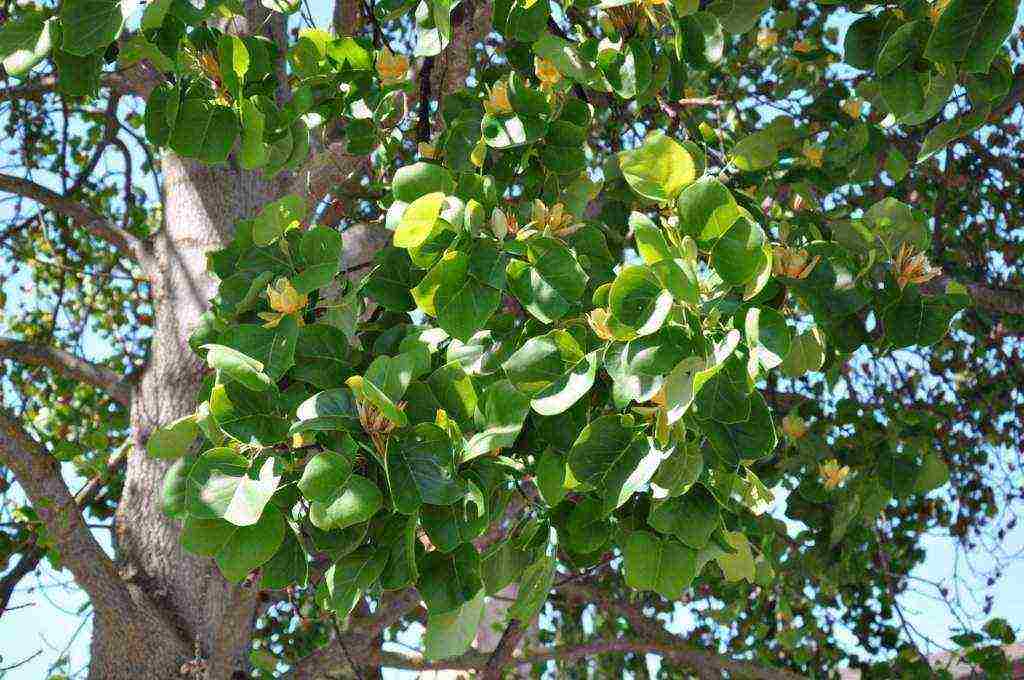
There are three types of tulip trees known:
Plants of the American variety are highly decorative and majestic in size, growing up to 50 m in height. Lyrate leaves of bluish-green color, up to 15 cm long, turn golden by autumn. The tree looks spectacular in autumn, it is, as it were, covered with golden openwork leaves. There are American states where liriodendron is a national symbol, a sign of family well-being and wealth. The Chinese variety of yellow poplar grows up to 15 m, sometimes found as a shrub. It looks somewhat different than other types, although its decorative effect is not worse.
It blooms with “tulips” up to 6 cm in diameter, colored green on the outside and yellow on the inside, without orange spots on the petals. Prefers a mild and cool climate, always humid. Recommended by gardeners for growing in the regions of Russia in the middle lane.
The homeland of the bell-shaped spatodea is the territory of West Africa, where it is called "ball lightning". This variety is distributed over vast areas due to its resistance to temperate climates. No less decorative than other varieties, liriodendron acclimatizes well and pleases with its flowering. In its crown, up to 100 bright red flowers bloom at the ends of the branches. The fast growing hybrid Liriodendron tulipifera x L. Chinense is especially popular among gardeners. 
Among the liriodendrons, there are centenarians, whose age is up to five centuries. With an annual growth of up to 1 m in height and 20 cm in thickness, gardeners can grow liriodendron in the Russian climate, the columnar trunk of which reaches 2 m in diameter.
Landing
Choosing a place on the site
An important point when planting a tulip tree is the choice of location on the site.
Gardeners recommend:
In the American eastern states - in the homeland of liriodendron, there is enough sunlight. Therefore, when planting it, we choose places that are well lit by the sun. We try to avoid the north side of the site. Remember that the tree easily tolerates hot summer temperatures and its leaves do not fade in the sun. The delicate branches of young trees break easily, so you need to choose a place without drafts, where the plantings are protected from the wind. When planning a garden plot, we take into account that the juice allocated by a tulip tree can harm garden decor items, so their placement under an overgrown crown is impractical. Landscape sculptures can quickly deteriorate, just like garden furniture. When planting, it is taken into account that over time, the liriodendron will grow to a huge size. Therefore, we place neighboring trees away from the yellow poplar. The distance between them should be at least 5 m. We plant a huge tulip tree growing away from housing. 
Americans call this plant a white tree; it should occupy an honorable spacious place in the garden.
Soil preparation
Exot needs a nutritious extract if the soil is depleted and contains insufficient nutrients, that is, it is necessary to fertilize it with humus or compost. The acidity index of the soil should not exceed 7.5, it is preferable to use neutral or slightly acidic soil for planting liriodendron.
The comfort of the yellow poplar will be provided by moist, well-drained soil. From stagnant moisture and from constant puddles near the roots, the tree can weaken and get sick.
It is not recommended to plant liriodendron in clay soil. Heavily warmed up and poorly ventilated, it almost does not allow water to pass through. If it is not possible to plant a plant in a different soil, then it is cultivated, peat and sand are introduced. They, in turn, help to loosen the soil and make it more permeable to moisture.
A seedling hole is dug a week before planting.
Its size should exceed one and a half times the volume of the root system of the tree. Part of the excavated soil is mixed with nutritional supplements, the other is useful for dusting the roots. If the soil is not entirely nutritious, then you can add 250 g of complex mineral fertilizer. Use broken bricks or rubble, which are placed on the bottom of the pit, as drainage.
Attention! Sandy loam soil and black soil are ideal for planting a tulip tree. When planting it in sandy soil, mulching is necessary. The plant will feel bad in soil rich in lime and salt.
Landing dates
Dates of planting a tulip tree in central Russia
depend on climatic conditions in the spring. Planting is possible with sufficient soil warming.
Selection and preparation of a seedling
When buying seedlings of tulip liriodendron, we look at the age of the grown tree, it should not be less than 4 years old, and at its height, ideally, at least 1 m.
The crown of the seedling sold must be at least 20-30 cm in diameter.
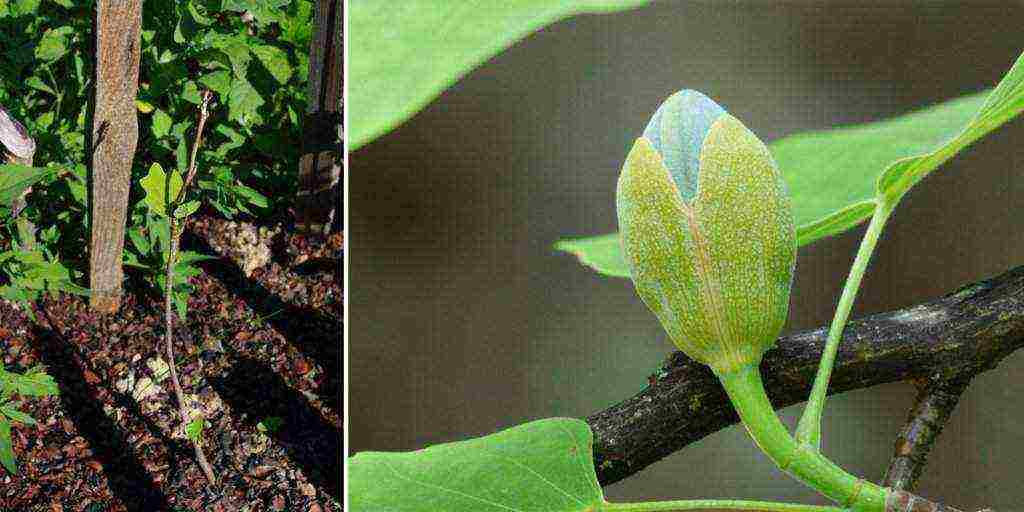
Varieties of tulip liriodendron adapted to Russian conditions: Roothaan mediopictum, Glen gold, Heltorf, Aureomarginatum, Fastigiatum, Ardis and Chapel hill. Plants of these varieties usually bloom with yellow or white tulips.
When deciding to buy liriodendron seedlings, pay attention to the condition of their root system. There should be as few dried fragments as possible and the complete absence of rotten roots.
When buying a seedling, the root system of which is open, planting is carried out within the next few days. Before that, the roots are kept in water for about three and a half hours.
Fragile roots require careful handling. The further growth of the tulip tree depends on their condition.
It is better to buy seedlings placed in transport containers. They can be stored for several weeks before planting, waiting for favorable weather conditions.
Planting a seedling
When planting a seedling of a yellow poplar, we observe the following recommendations of gardeners:
- When removing the seedling from the container, the soil is moistened, the container is placed on its side, the clod of earth with the root system is carefully removed. For better acclimatization of the tree and reduce stress, it is not recommended to break the earthen lump with roots.
- The level of placement of the plant in the planting pit should be the same as it was in the container, not lower or higher.
- When adding soil to the roots, the soil is compacted so that there is no room for air, no air pockets are formed.
- The planted tree needs a one-time abundant watering.
- For mulching the soil, you can use cut grass, humus and peat, which are laid out in a layer up to 8 cm. This procedure helps to maintain the optimal level of soil moisture, prevents it from overheating, and prevents weeds from growing.

If you follow the recommendations for proper planting, the trees will delight you with their flowering in a few years and in the very first summer they will delight you with the beauty of their foliage.
Features of caring for a tulip tree
The tree needs careful maintenance during the first two years of its life.
Young liriodendron needs pruning for proper crown formation. By removing the tips of the twigs, you can create a pyramidal shape that is convenient for a young plant.

The timing of the appearance of beautiful flowers is influenced by the planting and maintenance of trees, as well as the soil and climatic conditions. With regular watering, an abundance of organic matter, good looseness of the soil, the trees grow actively and bloom faster. Usually "tulips" appear after 5-8 years from the date of planting.
Tulip trees can grow without the need for additional care, loosening and feeding. But in this case, you will not have to rejoice at their flowering, or you will need to wait for this longer than with careful care.
The darkening of the tips of the leaves and their drying out indicates an excessively hot and dry climate. Yellow poplar needs additional moisture and more abundant watering.
Watering and fertilizing
Giving preference to high soil and air humidity, liriodendron needs regular, frequent, but moderate watering. In this case, it is necessary to control the presence of excess moisture, which can lead to decay of the roots.
The trees are watered with warm water, which can be heated in the sun in containers. In dry and hot weather, the tulip tree needs spraying, which is carried out in the evening with an inactive sun. For daily irrigation of the crown, you can use a special garden hose nozzle.
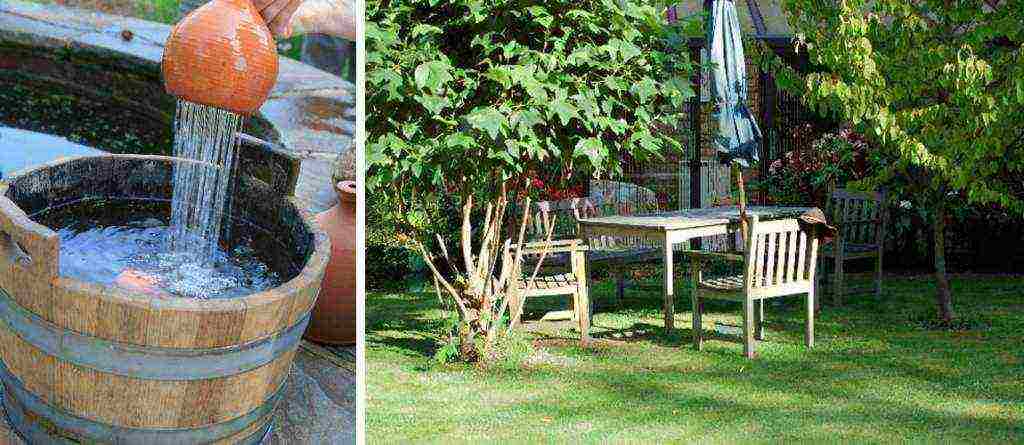
Top dressing is applied after the first year of life. The use of nitrogen-based mineral formulations is recommended as a spring fertilizer. Later, top dressing is used with the introduction of potassium-phosphorus fertilizers.
In the autumn, organic additives are added.
Attention! The use of poultry manure requires some knowledge of how to prepare the fertilizer for use.
Dissolve the droppings in water and keep this composition for several days. Before watering, the finished solution is still diluted, since it can burn the roots of the plant.

Humidity
It is very important for the moisture lover to ensure drainage before planting. An abundance of moisture leads to decay of the plant, which is destructive for it. Watering frequency also depends on climatic conditions, dry or rainy weather.
It is necessary to provide the necessary moisture for the plant, without killing it with an excessive amount of water.
For example, a tree planted in sandy soil needs frequent watering. Liriodendron growing in clay soil should be limited to watering.
Preparing for winter
Experts know about the frost resistance of the tulip tree, which can withstand up to 25-30 degrees of frost. But they warn that young trees need special care and attention, since they do not have the stress tolerance associated with weather conditions.
When preparing plants for winter conditions, it is recommended:
- renew the mulch layer after the autumn harvest of foliage, removing the old one;
- overlay the place of the near-stem circle with sawdust or compost, peat, wood chips up to 12 cm high;
- gently press the branches to the trunk and tie them with a rope;
- additionally insulate young trees with caps made of burlap or dense material, fixing them with twine.
If a harsh winter is expected, then lay a tree with spruce branches and snow.
It is necessary to know the weather forecast, especially during early spring. Under the bright rays of the sun, the plant can resist, and then the shelter is removed. The capricious spring weather sometimes unexpectedly brings a cold snap, and in this case, the trees must be immediately covered.
Diseases and pests of the tulip tree
Liriodendron is rarely attacked by harmful insects and is almost not affected by diseases.
If the tree has problems, then they are usually associated with inadequate care of it.
For example, in too hot and dry climates, the leaves begin to darken and dry out. In summer, foliage may turn yellow, indicating too bright lighting. In this case, the plant requires shading, which can only be provided for young trees.
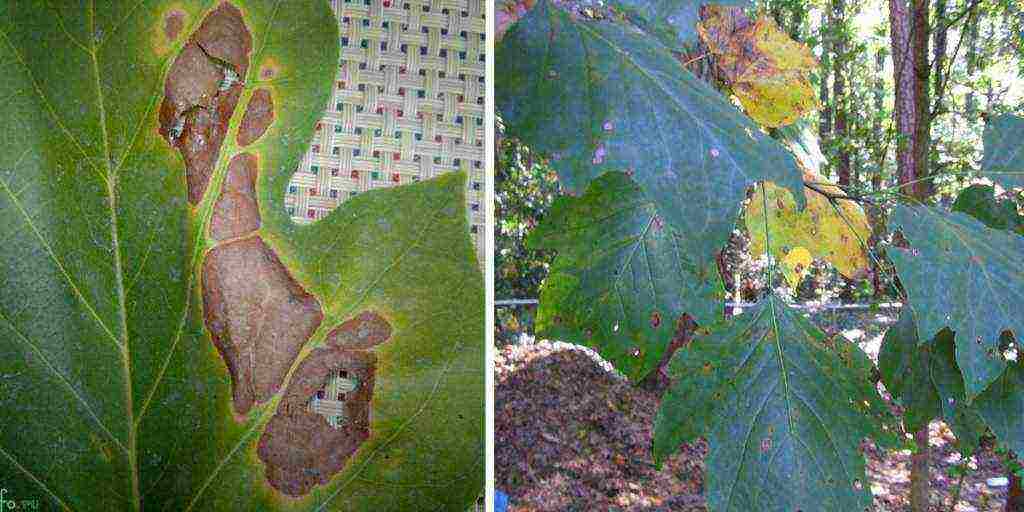
The color of the leaves determines whether the tulip tree has enough nutrients. When they turn pale, top dressing is necessary.
Liriodendrons growing at home are the most capricious.
Lovers of growing indoor trees are recommended:
- carefully treat the plants with special solutions at the slightest sign of pest infestation;
- monitor the state of the liriodendron for timely elimination of problems, changing the conditions for caring for it;
- fertilize the soil regularly;
- protect the plant from damage by pets, which can lead to its death.
If the owner of the tulip tree is often away, then it is better not to grow this exotic beauty at home.
Reproduction methods
The methods can be different. The tree is grown using cuttings, grafts, cuttings and seeds.
Reproduction of liriodendron requires patience and some knowledge. The most popular and preserving the varietal characteristics of the tree is the seedling method. Growing a plant from seed at home is almost impossible. But one should try.
The main thing to remember is that very fresh seeds are used for seedlings, which are no more than two days old.

When growing seedlings you need:
- Prepare the seeds. They crumble on their own from loose bumps that bloom in late autumn.
- Disinfect large seeds by soaking them in a light pink solution of potassium permanganate for two days. In this case, you need to change the water up to 2 times a day.
- Prepare a container for planting seeds by filling it with garden soil, coarse sand and low-lying peat in equal parts.
- Plant the seeds to a depth of 1.5 cm, water and put the leaves on top in a thick layer.
- Store the container in a cold place, even in an unheated greenhouse. Do not forget to cover the box with snow in the cold and water the soil in it during the spring thaws.
- Wait for the emergence of seedlings, the sprouts should hatch in a year and a half after planting the seeds.
- Rejoice in the amicable growth of seedlings, not forgetting to water them.
- Temper sprouts before planting in open ground. Carry out boxes with trees for a "walk", especially in sunny weather.
After disembarking, do not forget that young liriodendrons require care:
- moderate and frequent watering;
- spring and summer feeding;
- weeding;
- mulching the soil to retain moisture.
Subject to proper planting and care, the tulip tree will delight the owner with flowering at the age of 7, after which it will bloom into graceful “tulips” annually.
In Russia, the tulip tree is becoming more and more popular. When planting liriodendron, gardeners in the middle zone of our country need to purchase seedlings of the variety that is suitable for local climatic conditions.
Miracle trees blooming with tulips can be found in the regions of the Black Sea subtropics. Residents of Sochi and nearby resorts can admire the flowering of liriodendron from April to May. It is there that large alleys, decorated with these trees, grow.
A huge specimen of the miracle tree grows in the village of Golovinka on the Black Sea coast. It is more than 30 m high, about 2.5 m in diameter, and the crown is measured at 27 m.

The tree is a symbol of family well-being due to its longevity and amazing flowers. It is pleasant to gather under its crown for any family, no matter how large it may be!
Such beauty is worthy of the attention of gardeners and the necessary care.
Method 1 Choosing a place for poplar
-
 Look for an area where the soil is moist but well-drained.
Look for an area where the soil is moist but well-drained.
The tulip tree is suitable for clay, loam and sandy soils that are moist but well-drained. Their preference is given to acidic or neutral soils (pH 6.1-7.5). They can live in zones 4-9. Avoid planting the tree in dry, shallow soil.
- Tulip trees generally do not thrive in shallow clay soils and generally do not tolerate drought. However, there are several varieties of this tree that are native to Florida and are more drought tolerant than their cousins elsewhere.
-

Avoid heat and lingering puddles. Avoid planting the tree in a hot, dry part of the garden or wetland where puddles linger after rain. Tulip trees grow best in deep, saturated, moist clay soil that is well-drained. They prefer a sunny location, but will tolerate partial shade for several days.
-
 Consider planting a tree in your yard rather than your garden.
Consider planting a tree in your yard rather than your garden.
Although tulip trees are well-formed and attractive, they are too large for many gardens and have other disadvantages such as sap dripping and vulnerability to wind.
- They will not tolerate full shade, so if there is shade, it is a good choice to provide it to other plants if you decide to plant a tree in your garden. Of course, you will need to plant shade-loving plants around the tree.
-
 Be aware of sap and pollen.
Be aware of sap and pollen.
It should be noted that some people are allergic to pollen. The tree is notoriously sap dripping. This is annoying, especially if your newly washed car is parked under a tree. The sap is also carried away by the wind.
- If you are planting a tree in your yard, make sure it is away from the road so that the sap does not get onto your car.
Method 2 Planting a tree from a seedling
-
 Prepare the soil ahead of time.
Prepare the soil ahead of time.
When planting any seedling, it is always best to prepare the soil in advance. Add some compost or well-rotted manure to the tulip site. For this:
- Add a layer of compost and then rake in the soil that is already there.This will give the soil an extra boost of nutrients.
-

Plant your tree shortly after purchasing a seedling. The seedlings are supplied bare-root or in pots. If you are using bare-root plants, try to plant them immediately after purchase, as they will not survive for a long period of time if left uprooted.
-
 Prepare the seedling for planting.
Prepare the seedling for planting.
Remove all ropes and wraps supplied with the seedling. Soak roots before planting. For this:
- Place the tree in a bucket of water (ideally rainwater) for several hours; don't let him stand all night. Avoid removing roots or damaging them.
-
 Dig a hole.
Dig a hole.
Dig a hole as deep as the roots of the trees and twice the width of the roots. If your plant was placed in a pot, the soil level in which you plant the tree should be the same as the soil level in the pot.
- If the plant was supplied with bare roots, check the stem of the plant to see where the soil level was before.
-

Loosen the roots. If the roots are bunched together, try and loosen them by straightening them a little, as gently as possible. When using a potted seedling, try to retain as much of the original soil as possible, as this will help preserve the roots.
-
 Plant a tree.
Plant a tree.
Place the seedling in the hole you created. Cover with soil around the seedling. To avoid air pockets, compact the soil well and then water the seedling thoroughly.
- However, do not compact the soil too much, as this can damage the roots.
-

Add mulch to the area. Apply mulch with about 10 cm of compost, rotted leaves or well-rotted manure on the soil surface. Make sure the mulch covers the entire area under the tree. This will help protect roots, curb weed growth, and retain moisture in the soil.
Method 3 Planting a tulip tree from cuttings
-
 Take a stalk from a healthy tree.
Take a stalk from a healthy tree.
Tulip trees can be grown from seeds or cuttings. Growing from seed will be discussed in the next section. To take a stalk:
- Cut about 45cm fresh growth (less than 2 years old) from a healthy-looking tulip tree.
-
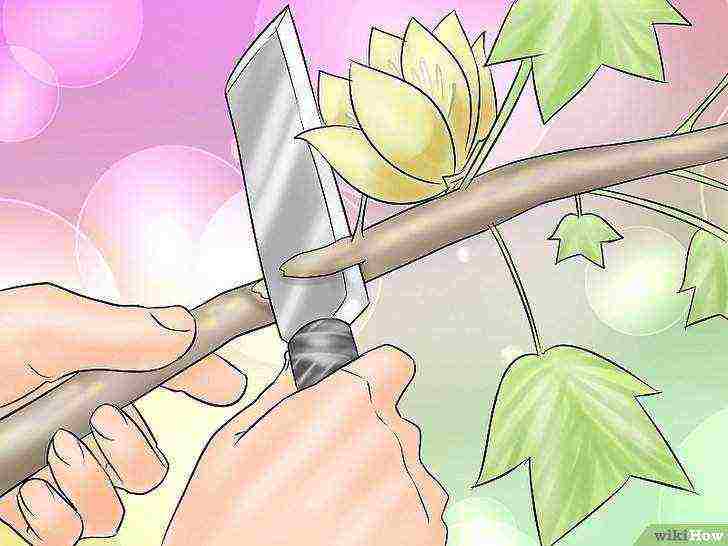 Cut off leaves or flowers.
Cut off leaves or flowers.
Along with the leaves and flowers, you should also trim the bottom 5 cm of the bark using a sharp knife. Dip the peeled end into rooting hormone, then plant it so that about half of the cutting is in the compost pot you chose for the cutting.
- You should plant the cuttings in a compost mixture that is suitable for cuttings.
-

Keep the cutting in a place where the sun is bright, but out of direct sunlight. One way to do this is to place the pot in a clear plastic bag and remove it every few days to prevent condensation from building up. After a few months, the cutting should take root. If rooting is successful, he should resist a light pulling motion with his hand.
-
 Move the cutting outward.
Move the cutting outward.
After a few months, you can try planting the cutting outside in partial shade (away from the intense midday heat).
- Once the stalk is rooted and a little tougher, you can move it wherever you want, be it your yard or garden.
Method 4 Planting a tulip tree from seed
-
 Consider planting a poplar from seed.
Consider planting a poplar from seed.
If you choose to plant from seed, don't wait until October for the seeds to ripen. Dry them over a few days on a plate or tray at home. Once dry, soak them overnight in warm water.
- If you delay planting until spring, keep the seeds in the refrigerator in a plastic bag in the winter, along with a lightly dampened mixture of sand and peat.
-
 Mash the seeds.
Mash the seeds.
After you've dried and soaked them, you need to crush the outer coating of the seeds to help them germinate. For this:
- You can use sandpaper or wire mesh to scrape the outside.
- You can also use a sharp knife to cut the seed.
-
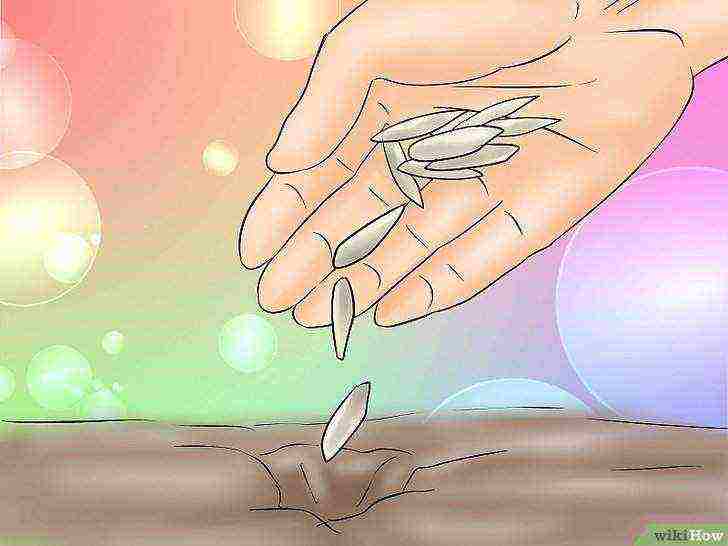
Plant your seed. The seed should be planted 0.6 cm deep in a garden free from the scorching midday sun. Keep the seed watered until it takes root, but do not flood.
-
 Take care of the tree when it is rooted.
Take care of the tree when it is rooted.
Tulip trees do not require pruning. Young trees can be devoured by rabbits and deer, so consider protecting young plants for the first few years if this is a problem in your area.
- You should water the young trees during dry periods until they are well established: usually during the first 3-4 years of life.
- If your tree is shedding leaves early, this indicates drought.
Tips
- Since the fast growing varieties of this tree can reach almost full height in just a couple of decades.
- These trees will bloom in late spring and early summer.
- These trees are deciduous, meaning they lose their leaves in the fall.
- Some people complain that they have never seen flowers, as they are not always visible from the ground in adult specimens.
- These trees are slightly more vulnerable to wind than other trees. This could mean that higher branches will be damaged or broken during windy periods.
Article Information
This page has been viewed 6,951 times.
Was this helpful?
Content:
- tulip tree: botanical description
- tulip tree: when it blooms
- tulip tree at home
- tulip tree in Golovinka
- african tulip tree
- tulip tree: photo
Tulip tree botanical description
Tulip or tulip tree, or liriodendron tulip (Liriodendron tulipifera) is a very beautiful tree. Tulip tree in wikipedia also has such names: tulip poplar, yellow poplar. Genus name Liriodendron comes from the Greek words leirion (lily) and dendron (tree). This name suggests that the flowers of the plant resemble lilies. But it is not so. Both flowers and leaves of this plant are similar to tulip inflorescences. This tree is called the tulip poplar. This fact again leads to confusion, since the tree belongs to the magnolia family, not poplars.
Tulip tree - this is a large tree, reaching a height of more than 30 m, and in some specimens it reaches a height of up to 100 m. homeland - the eastern regions of North America. It is a deciduous and fast growing tree with a tall and straight trunk and a wide crown that is slightly less than half its height at maturity. Branches start far up the trunk and are often symmetrical. The bottom “fork” is usually absent. The upper branches create a rounded or pyramidal crown; in open areas, the plant has a vertical, oval or conical crown. The trunk has a light gray-green bark and can reach an impressive size of 1.2 to 1.8 m in diameter... Young trees have smooth bark, while mature trees have white rhomboid bark. Shoots are brown, waxy. If the branches are damaged, you can catch a sweet spicy aroma.
Tulip trees can be identified in form their leaves: their shape is unusual, the so-called lyre. It looks a bit like a tulip flower. Each leaf is simple, wide, with venation. Consists of four short lobes, with an inversely cordate, notched apex. Concavity at the tips of the leaves, or where one would expect a typical tip, suggests someone came in and took a piece of them! Leaf color - light or deep green in spring and summer and golden yellow in autumn. The leaves are rather large, 12 to 20 cm long.
Flowers very effective and reminiscent bud tulip... They are medium in size (5-8 cm in length), yellowish-green, with a tinge of orange (orange stripes at the base of each petal) on the outside, cupped, "looking" upwards.Fragrant. Blossom in late spring. But flowers can go unnoticed on large trees because they appear after the leaves have fully bloomed. Flowering period: May June. Flowers are replaced by dry, oblong, conical fruits brown in color, each containing numerous winged seeds.
Is growing liriodendron tulip full sun or partial shade, wet, well-drained soil with a lot of humus. It can also adapt to less ideal conditions such as dry soil. Often a tree does not bloomuntil it reaches at least 15 years. The tulip tree gives a very large shade. It is planted on lawns or used for large landscapes. As a rule, it is not recommended to plant it as a street tree. The tulip tree is valuable source thin wood that is used to make furniture.
Tulip tree when it blooms
The tulip tree is impressive and mesmerizing with its beauty. It is a very unusual, vibrant and conspicuous plant. Usually begins to bloom late May, blooms until mid-June. Flowers appear after the foliage has blossomed. Sometimes on large trees it is difficult to see the buds, because they are hidden by leaves. Externally flower very similar to a tulip. It should be noted that young trees rarely bloom. Usually, a tulip tree begins to delight with its gorgeous flowers only after Fifteen years after landing! If you want straight now decorate the garden with flowering trees, then it is better to choose another plant and not wait so long for the first buds to appear. Liriodendron is a gorgeous plant for the future. An experienced landscape designer will definitely find a use for it.
Tulip tree at home
At home There are two ways to grow a tulip tree. The first way is to use seed, and second - cuttings... If you want to use for breeding the seedsthen be sure to choose only fresh seeds. They get from fruitsthat form after the tree has flowered. Ripe fruits fall, and you can easily get the seeds. The shape is four-sided. The seeds are planted in a spacious container, the soil is suitable for universal. If you propagate a tree by seed, be patient. The tree will grow very slowly... It is best to use the second method - to propagate the liriodendron cuttings.
Home care. This plant loves wet soils, but is afraid of excessive waterlogging. The soil necessarily must be drained. Clay, loamy and even sandy soils are suitable. It can grow on acidic and neutral soils. Upper layer should be more nutritious, chernozems are suitable. Twice a year you can feed complex fertilizers. If you grew a tree in a container, then plant it can be buried in the ground at any time, except for the winter period. Tulip tree perfectly tolerates Ukrainian frosts... Not afraid of thirty degrees below zero. The tree is good adapts to urban conditions, to noise, dust. Very rarely sick, and also damaged by fungi.
Be careful to the landing site. The tulip tree loves space, grows poorly next to other large trees. If your the garden is very small, it is better to refrain from planting the liriodendron. This tree will look spectacular in large city parks and gardens, as well as in spacious private areas. Not suitable for a regular summer cottage or for a mini home garden. An adult tree gives huge shadow... This has its pros and cons. Benches can be placed under the shade of a tree for rest. But if your garden is very small, then the shadow will take up all the space, and this will to influence badly on the growth and development of herbs or flowers.
If you want to decorate your garden with this plant, then you are unlikely to encounter difficulties, Liriodendron adapts well to any conditions, it will certainly delight you with its beauty.
Tulip tree in Golovinka
Unique specimen tulip tree grows in Sochi, or rather in the village Golovinka Lazarevsky district. Many plant lovers come to see and photograph this majestic and incredibly beautiful tree! What is its uniqueness? This specimen is mesmerizing with its huge size. Height wood - thirty meters, diameter trunk - 2.4 meters, and crown size - as much as 27 meters. Even ten people cannot embrace this mighty tree.
They say that this tree already three hundred years! Lightning struck him, but the tree still continues to grow and develop. According to the legend, this tree grew in North America, but in 1813 it was brought to the Yalta Botanical Garden, and from there it got to Golovinka. General Raevsky transported him to Russia in 1840.
Many tourists specially come to this tree. They say that if you sit in its shade, you can be cured of various diseases. Some people hide coins in the hollow of a tree, because it brings good luck, as well as wealth. You can come to the tree on your own or as part of a tourist group. Many guides lead people from different parts of the world to this tree.
Tulip tree in Golovinka:
African tulip tree
African tulip tree is also called Bell-shaped spatodea (Spathodea campanulata). This is a beautiful tree from the Begoniaceae family, which pleases and impresses with its very abundant and bright flowering. Plant size - from seven to twenty five meters! Flowers bell-shaped, yellow, red-orange. Outwardly, the flowers are similar to a tulip, but collected in a brush. They always look up, the height is up to 20 centimeters. The buds often collect moisture from the rain, which attracts different birds.
Growing an African tree in your garden... If you want to complement and decorate your garden with this gorgeous plant, then you need to know the basic rules of plant care. Choose sunny and bright place for planting. To water wood is needed often, but in moderation. There is no need to overmoisten the ground, dry periods are also bad for the plant. Grows better on nutrient soils, although it can grow on poor soils. Seeds it is better to plant in loose and moist soil, cover with foil. In summer and also in spring, once a month is better fertilize your tree with special fertilizers. Starts blossom African tulip tree in the third year after planting, but not earlier. Optimum temperature for summer - up to 26 degrees above zero, and for winter - 16 degrees below zero. Therefore, can not be planted tree in the north of Ukraine.
Tulip tree: photo
Published: 03.09.2016
Related articles:
- Lianas in decorative design
- Pond in the garden: step by step
- The principles of designing and organizing a garden. A fabulous corner instead of a disorderly clump of plants
- 10 steps to creating an ecological garden
- Annual work calendar: flower garden, garden, vegetable garden


